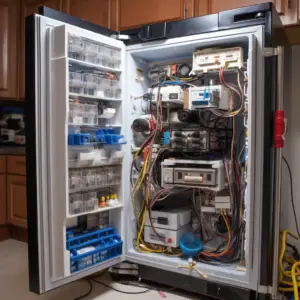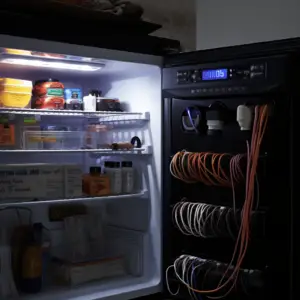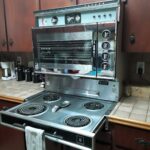When your refrigerator has a tripping GFCI, you are likely to face many problems. Your generator may turn off randomly and can cause your food to spoil.
This article will show you what causes GFCI to trip and how you can fix it. But before that, let’s discuss what a GFCI is and its uses.
Table of Contents
What is GFCI?

GFCI is the short form of “ground-fault circuit interrupter.” It is designed to save you from electric shock in your home, especially in areas where water is likely to be, such as the bathroom and kitchen.
GFCI is built into a power socket, unlike the fuse circuit. When your refrigerator comes into contact with water while connected to the GFCI, it automatically switches off the refrigerator.
Follow the mentioned steps to fix a Tripping GFCI outlet;
Reset the GFCI
Refrigerator GFCI Tripping , Your first step is checking the outlet. You will know if it is a false alarm or a true signal. The device is very sensitive, and a slight change in the environment results in ‘nuisance trips.’ The device disengages even when there is no issue.
During hot weather, it is common, and you must test your fridge by plugging it into the outlet. If the tripping happens frequently, you will need to check for the issue. Go through the owner’s manual, and if you cannot fix it, call an electrician. After the test, reset your GFCI. Monitor your fridge if tripping occurs again, then you will need to replace it.
Use a Snubber
If you use your refrigerator with a GFCI outlet near the vapor compressor, you have to be careful because your GFCI outlet may trip when you unplug the refrigerator. The best option is to use snubber to continue using your refrigerator.
The snubber reduces the effects of interference that the devices can cause by generating resistance on the ground circuit. The snubber has to be installed between the refrigerator and the GFCI device.
Check the Power Cord
Checking your power cord is another important step. When your fridge gets damaged, then a short circuit often occurs. Unplug and inspect your power cord to check for any damages. Signs of damages on the power cord are holes, worn-out insulations, and rodent bite marks. You can move to the next step. It is fine, in case of any damages, you will need to replace it.
Check the Power Plug
You might have overloaded the circuit that your refrigerator is plugged into. It is another common cause of GFCI tripping. When many appliances are plugged into the same circuit, tripping is inevitable.
To avoid it happening, ensure that your refrigerator is assigned an exclusive circuit that can allow you to plug your refrigerator into another power source to check if it will still trip. If you realize it doesn’t trip anymore, set aside a circuit for your fridge and ensure it is the only appliance connected to it.
Check the Power Outlet
The power outlet that your refrigerator is plugged in should be checked. Begin by turning off the circuit breaker. Then remove the plug from the wall outlet. You then remove the cover on the power strip and look for signs of burned spots on the wires and any blackened sites. Also, check for loose connections.
In case of any signs, disconnect them from the power outlet and replace them with new ones. Check the outlet for continuity using a multimeter. In case of discontinuity, then you will need to replace them. You must engage a qualified person if you have no expertise. If your outlet is not damaged, then move to the next step.
Consider Circuit Breaker Issue
After considering all the above steps but in vain, check the circuit breaker’s condition. You have to check the entire breaker box to ascertain any damage. In most cases, the damages are: generally worn out, corroded, or cracked.
In case of these, then you will need to replace them. The repair is dangerous, and you should only do it if you have the qualifications. You must also be aware that the type of breaker panel will dictate the correct procedure. If you are not sure, seek assistance from a qualified electrician. If your circuit breaker is in good condition, move to the next step.
Check for Faulty Refrigerator Wiring
Your next step is checking the wiring of your refrigerator. In case of failure in cooling food, the wiring should be your first check. You have to unplug the fridge before taking any action. You will also have to remove the lower part of the refrigerator and inspect damages.
Also, check for loose connections. You will check if they should be repaired or replaced. You must involve a licensed electrician when undertaking any repairs. If wiring is fine, then check the next component.
Check for Faulty Defrost Heater

The defrost heater ensures no formation of ice in your refrigerator. A faulty defrost heater can cause tripping GFCI. The heater becomes weak with time and thus unable to produce enough heat.
You have to reset the timer to go to the defrost cycle to test your refrigerator. When the defrost cycle happens, you have to stay near to monitor the GFCI outlet. If GFCI drips within the first five minutes, then it means that your refrigerator’s defrost heater is damaged. If the trip does not occur, you can move to the next step.
Check for Defective Compressor
If you have done all the tests and still have not traced the source of the problem, then it must be a defective compressor. With continued use, the winding of your compressor fails to force your refrigerator to work extra time to generate enough power to the compressor.
Consult a licensed electrician to check for any default you might have missed.
Replacing a compressor is so expensive that you might feel better off acquiring a new one.
All in all, that’s about it in, “How to Stop a Refrigerator from Tripping a GFCI Outlet.”


